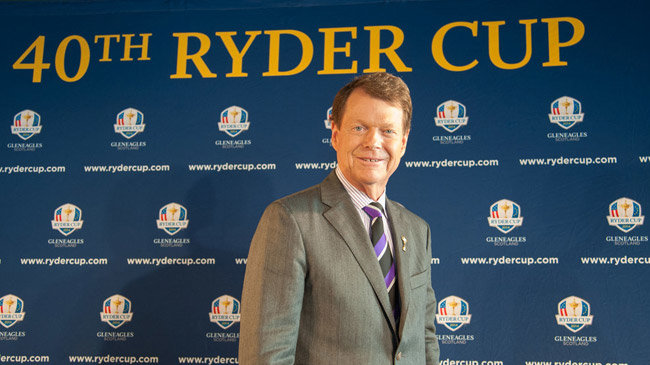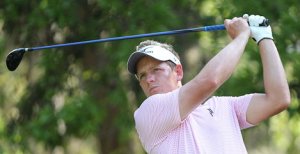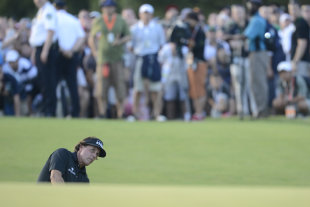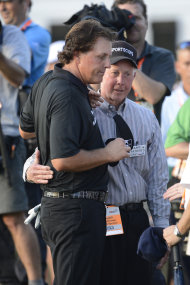Course Source: Chambers Bay GC, Wawona Hotel GC
Tom LaMarre, The Sports Xchange June 10, 2013 2:00 AMThe SportsXchange
IN THE PUBLIC EYE: Chambers Bay Golf Course in University Place, Wash., five miles south of Tacoma and 45 minutes south of Seattle.
THE LAYOUT: Boasting a traditional links layout along the picturesque shores of Puget Sound, Chambers Bay received national acclaim well before its highly anticipated opening late in June 2007.
Already it is making history.
Chambers Bay is the first course opened since 1962 that will hold a U.S. Open, having been selected to host the national championship in 2015, when it will become the first course in the Pacific Northwest to be the site of the event.
Bandon Dunes in Oregon, another unique layout sometimes compared to Pebble Beach, was expected to be the first Pacific Northwest course to play host to the Open, so the selection of Chambers Bay was considered something of an upset.
Chambers Bay, which will join Bethpage Black in Farmingdale, N.Y., and Torrey Pines near San Diego as the only municipal courses to host the U.S. Open, received something of a dress rehearsal by hosting the 2010 U.S. Amateur.
Architect Robert Trent Jones Jr. was hired because of his unique vision for the 930-acre park, a sand and gravel quarry bought by Pierce County for $33 million in 1992.
Jones' firm didn't seek to simply copy the successful blueprint laid out by Bandon Dunes (both courses are managed by Kemper Sports). The goal was far loftier -- to provide a unique opportunity to play true Scottish links golf courtesy of the natural elements of the land and maritime weather.
Course developers removed all but one tree, a Douglas fir that stands behind the 15th green and near the 16th tee above the waters of Puget Sound. "The Lone Fir," as the tree has become known, was damaged a few years ago by vandals, but work by agronomists apparently has saved it.
Nearly 1.5 million cubic yards of dirt and sand were removed to create the course, which is located below the snow-capped Olympic Mountains. The end result is a fabulously designed layout that features miles of sandy wastelands, dunes and rolling hills that force golfers to understand the nuances of the course to avoid serious trouble on any given hole.
The wind and rain the Northwest is known for has transformed the property into a links paradise. But there's no question there is plenty of length and difficulty to satisfy USGA standards for the U.S. Open -- 7,585 yards from the back tees with a 76.9 rating and 135 slope.
GENERAL MANAGER: Matt Allen.
HEAD PROFESSIONAL: Nicholas "Nyk" Pike.
LOCAL KNOWLEDGE: It only takes stepping out of the car to know a serious challenge awaits. The pro shop sits atop a cliff overlooking the 930-acre park, with a shuttle transporting golfers down to the course.
No golf carts. This is designed to be natural Scottish links golf, after all.
But there are plenty of caddies who, for $35, will carry your clubs and offer insight as you walk the approximately 7.5-mile course (one caddy said the standard tip is around 100 percent).
Whether a caddy is worth $70 in addition to the $155 to $205 weekend greens fee for non-residents depends on your pocketbook and patience quota for quality shots that end up in impossible places.
And there is ample opportunity to pull out the wrong club on nearly every hole as the course winds its way up and down the hillside. One of the few holes without a major elevation change is the par-4 opener -- a 465-yard tester for the average golfer and a 498-yard monster for the pros.
A new course with plenty to prove to justify its $20.7 million price tag, the friendly caddies will offer token pre-round advice if you opt to lug your own sticks.
Tip No. 1: Don't mess around in the sandy wastelands. Take your medicine and fight your way back into the fairway at all costs. It only takes one attempt to be a hero out of the heavy, coarse sand to realize you should have heeded the advice.
Tip No. 2: The fescue grass tends to grow toward the sun, and can slightly change direction during the day, so putts don't necessarily roll toward the water.
Tip No. 3: Over-club on No. 7, named "Humpback." No, not after the whale. At 449 yards from the medium "Sand" tees and 508 from the back "Teal" setup, it's a sharp dogleg right uphill around a vast wasteland. A well-struck drive leaves the average golfer 180 yards straight uphill over a massive dune smack in the middle of the fairway. Club up two, because the false front on the green sends shots that come up short straight back down the fairway a good 50 yards.
Should make great television for the U.S. Open.
Signature hole? The shuttle driver claims to have "narrowed it to 12."
For the sake of debate, we'll go with the par-3 15th. It's a rather innocent-looking 127-yard short iron tee shot, but there's nothing innocent about the elevated tee box that looks directly out at the lone tree and dramatic views of the surrounding area.
Three holes later is the excellent par-5 18th, the No. 2 handicap hole, featuring the massive relics of concrete sorting bins from the property's mining days lining the right side. At 514 yards from the Sand tees and 604 from the Teal with an elevated, multiple-tiered green, it's a trying conclusion to a round likely to push the six-hour mark.
OTHERS COURSES IN THE AREA: While the hefty greens fees of Chambers Bay are due to the county's need to log approximately 35,000 annual rounds averaging around $100 per golfer, there are several more outstanding golf courses within a short drive that won't tax the wallet quite so heavily.
A half-hour drive takes you to Trophy Lake in Port Orchard, a favorite among local golfers for its challenging layout and beautiful topography. Another 15 minutes up Highway 16 you reach Bremerton and the doorstep of Gold Mountain, which boasts two 18-hole championship courses. The Olympic course played host to the 2006 U.S. Amateur Public Links Championship.
WHERE TO STAY: If it's an overnight stay for the purpose of playing Chambers Bay, there are numerous hotels and motels in University Place and Tacoma. For those interested in wagering a few dollars and watching live entertainment, the Emerald Queen Hotel & Casino is one mid-level option.
If you're planning to stay for a few days, cross the Narrows Bridge to the quaint town of Gig Harbor. Located along the shores of Puget Sound, Gig Harbor offers good food, great scenery and plenty of lodging options. The Maritime Inn is a boutique hotel downtown, and there are several bed & breakfast options to choose from.
ON THE WEB: www.chambersbaygolf.com
--Chambers Bay course review by Derek Harper, The Sports Xchange
THE LAST RESORT: Wawona Hotel Golf Course in Yosemite National Park, Calif.
THE LAYOUT: Alister MacKenzie, primarily known as the architect
Bobby Jones hired to design Augusta National, left quite a legacy in California as well.
Among the masterworks he created are Cypress Point in Pebble Beach, Pasatiempo in Santa Cruz and the Valley Club of Montecito near Santa Barbara.
MacKenzie has been is credited in several places, including California Golf Guide, as the designer of the Wawona Golf Course, the only golf course within the boundaries of a national park in the United States.
However, research has turned up no evidence that MacKenzie ever walked the property in the High Sierra, where the golf course blends seamlessly with the towering pines near the famed Mariposa Grove of giant sequoias, the largest and oldest living things on earth, and Glacier Point.
However, it seems likely that designer Walter Favarque of San Francisco consulted on plans for the layout, which opened in 1918, with MacKenzie and Peter Hay -- whose family was instrumental in the development of Pebble Beach.
The nine-hole Wawona course was intended to expand to a full 18 when it opened in 1918, but the federal bureaucracy, which holds jurisdiction, has made it impossible.
The sporty 3,017-yard layout, which plays to a par of 35, meanders through forest and meadows bisected by several streams, and includes two par-5s, three par-3s and four par-4s.
Two sets of tees allow the golfer to play 18 holes at a length of 6,015 yards and a par of 70, with a USGA rating of 69.1 and a slope of 117.
Wawona is one of the few organic golf courses in the United States, with no pesticides used on the grass, and it is watered strictly with recycled grey water. Also, the course is a certified Audubon Cooperative Sanctuary.
Related Images

.
John Peterson tees off on the eighth hole during the …View »

.
Serena Williams - Day 9 U.S. OpenView »
07:24

.
Marcus Fraser, of Australia, tees off on the eighth …View »

.
Huntington Beach takes Wet Electric to court in wake …View »
02:28

.
Golfer Tiger Woods watches his tee shot on the ninth …View »The course, which is in snow country, is open from May to November.
GENERAL MANAGER: Alice Harton.
LOCAL KNOWLEDGE: The strength of Favarque's course is at the start, with a sweeping, uphill dogleg left 464-yard par-5, followed by a challenging 229-yard par-3 from an elevated tee, and a 470-yard par-5 through a chute of trees.
Don't be deceived by the relatively short par-5s because No. 1 plays dramatically uphill on the second and third shots to an elevated green, while No. 3 is extremely narrow off the tee and on the approach.
Best hole on the course and the signature at Wawona is the 420-yard seventh, which plays up and over a ridge on the blind tee shot and then straight downhill to the green through a corridor of sequoia and ponderosa pine trees that have given the hole the name "Cathedral."
A plaque near the green commemorates the first community in Yosemite established by Galen Clark in 1856. The exact spot of the settlement is located about 50 yards into the woods behind the green.
Another unique feature of Wawona is a periscope on the 349-yard fifth tee, required because of another blind tee shot. Be sure to check the periscope to see that the group ahead is out of range before hitting your tee ball.
The 185-yard sixth hole is called "Nursery," with the green located in a peaceful clearing where deer and bear often come out of the woods with their young to seemingly watch the golfers.
After you finish the 371-yard, par-4 ninth hole, check the position of the practice putting green across the road in front of the clubhouse, because that was the original green for No. 9 before two-lane Highway 41 was cut through the property.
The rest of the greens are not original, either, because when the par-3 course at the venerable Ahwahnee Hotel in Yosemite Valley was shut down in the late 1970s, course superintendent Kim Porter had the classic bent grass greens dug up and moved to Wawona.
OTHER COURSES IN THE AREA: If you are driving from Fresno and looking for a place to play on the way to Yosemite, stop at Brighton Crest Country Club in Friant, which features a course designed by Johnny Millerlocated across the road from Table Mountain Casino.
In the town of Ahwahnee, about 22 miles from the Yosemite, are the 27-hole, semi-private Sierra Meadows Country Club and the well-maintained River Creek Golf Course.
Also on the road to Yosemite is the nine-hole Yosemite Lakes Park Golf Course, designed by noted golf course architect Bob Baldock and opened in 1965.
WHERE TO STAY: Wawona Golf Course is located along the South Fork of the Merced River in a tranquil, pastoral setting across Highway 41 from the rustic Wawona Hotel, a national historical monument that was built in 1856.
The Wawona Hotel is a cluster of eight white wooden New England-style buildings set on a huge lawn of what was the site of Clark's Station. Galen Clark, Yosemite's original superintendent and guardian, chose a spot that the local Miwok Indians called "Pallachun," or "a good place to stop," to build a lodge.
Henry Washburn renamed the site Wawona, which is Miwok for "Big Trees." In 1876, Washburn built Clark Cottage, the oldest structure in the complex, followed by the main hotel building in 1879.
Most of the 104 guestrooms open onto the Wawona's signature verandas and are reminiscent of European-style hotel rooms. The rooms are furnished in period pieces and antiques. There are no telephones or televisions.
Among the other summer activities for hotel guests are tennis, swimming, hiking and fishing. Winter sports include cross-country skiing, snow-shoeing and alpine skiing at nearby Badger Pass Ski Resort.
President Teddy Roosevelt had lunch with at Wawona in 1903 while visiting Yosemite with naturalist John Muir. Other presidents who visited Wawona include Ulysses S. Grant, William Henry Harrison, Rutherford B. Hayesand William Howard Taft. Poet Ralph Waldo Emerson also passed this way.
Famous contemporary guests include Robert Redford and Brad Pitt.
Accommodations in Yosemite Valley, 30 miles to the north, include the historic Ahwahnee Hotel, which opened in 1927, and Yosemite Lodge, which is located at the foot of majestic Yosemite Falls.
Just outside the entrance to Yosemite are the Tenaya Lodge at Yosemite in Fish Camp, the Evergreen Lodge in Groveland and the Best Western Yosemite Gateway Inn in Oakhurst.
Atricles Course: http://golfatn.blogspot.com/
 .View gallery
.View gallery













